 |
| |
|
|
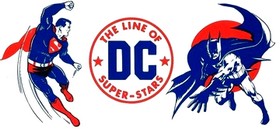 |
|
BATMAN,
SUPERBOY & SUPERMAN
BACK
TO BACK IN A
FEBRUARY
1973 DC SUPER PAC
|
|
|
|
| |
|
| |
|
| |
|
| |
DC COMICS
SUPER-PACs |
|
The early 1960s
brought both good and bad major
changes for the comic book
industry. The hugely successful
comeback of the superhero genre
created a streak of new
opportunities and creativity. At
the same time, however, small
stores which had carried comic
books for decades were pushed out
of business by larger stores and
supermarkets, and newsagents
started to view the low
cover prices and therefore tiny
profit margins comics had to
offer as a
nuisance. Many ideas on how
to turn these developments around
were put forward by different
publishers, but the most
successful concepts strived to
open up new sales opportunities
and markets and thus tap into a
new customer base. One place
these potential buyers could be
found was the growing number of
supermarkets and chain stores.
But in order to be able to sell
comic books at supermarkets, the
product would have to be
adjusted.
|
|
|
|
| |
| Handling
individual issues was no option for these
outlets, but by looking at their logistics and
display characteristics, DC Comics (who came up
with the Comicpac concept in 1961) found
that the answer to breaking into this promising
new market was to simply package several comic
books together in a transparent plastic bag. This
resulted in a higher price per unit on sale,
which made the whole business of stocking them
much more worthwhile for the seller. The simple
packaging was also rather nifty because it
clearly showed the items were new and untouched,
while at the same time blending in with most
other goods sold at supermarkets which were also
conveniently packaged.
|
|
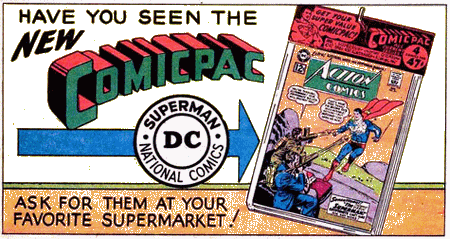 |
|
| |
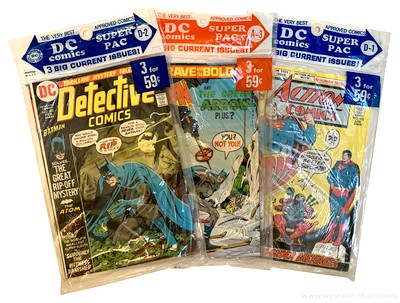
|
|
Outlets were even
supplied with dedicated Comicpac
display racks, which enhanced the product
appeal even more. It didn't matter
therefore that buying these three comic
books in a comicpack for say 59¢ (rather
than from a newsagent for 60¢ in that case) clearly presented no
real bargain - it was the opportunity and
convenience to pick up a few comics at
the same time parents and adults did
their general shopping. Neatly
packaged, it almost became an entirely
different class of commodity. DC's
"comicpacks" were, in a word, a
success - so much so that other
publishers quickly started to copy it.
"The
DC [comic packs] program lasted well
over a decade, with pretty high
distribution numbers. The Western
program was enormous - even well into
the '70s they were taking very large
numbers of DC titles for distribution
(I recall 50,000+ copies
offhand)." (Paul Levitz, in
Evanier 2007)
|
|
|
| |
| By the
early 1970s, DC relaunched their comicpacs, calling them DC
Super Pacs, and they continued to sell well
throughout the 1970s. |
| |
|
| |
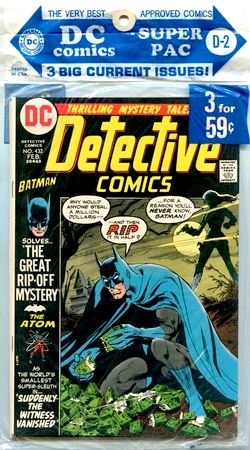 |
|
This February (D-2) 1973 DC SUPER PAC bundles together Detective
Comics #432, Superboy #193, and Action
Comics #421, making it an all-out superhero
comicpack featuring two flagship DC characters
(Superman and Batman). Right
from the start in 1961/62, when DC Comics
launched the Comicpac, all of their
multi-comic packs were reference-numbered using a
letter plus digit, e.g. B-3. And since DC wasn't
just filling plastic bags at random with any
comic books, a B-3 pack from a specific year
would carry the same titles and issues no matter
where or when it was sold (rare packaging errors
aside).
By 1964 the digit would
refer to the month and contain comic books with a
January cover date (or January/February in the
case of bi-monthly titles), and the letters (A
through D) marked the four different packs per
month (which was the rule from mid-1972 to 1978,
when DC ended their own comicpacks).
"D-2" therefore denotes the fourth
February SUPER PAC, in this case from 1973.
|
|
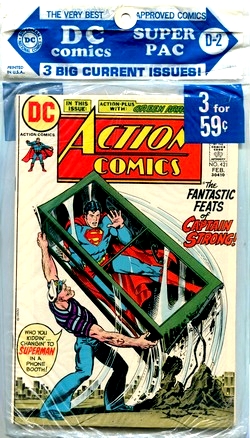 |
|
| |
| No
titles had truly permanent slots in the SUPER
PACS, although there was a high level of
consistency with DC's flagship characters (the
data for 1973, for example, shows
that the SUPER PACs of that year offered
buyers complete runs of Superman and Batman
as well as the Batman team-up title Brave and
the Bold). But since sales points could vary a lot with
regard to their supplies and selection of SUPER
PACs, the availability of specific titles was
never guaranteed - which in reality was the common fate of the
average comic book reader in the 1970s Bronze
Age, whether their comic books came packaged in a
plastic bag or as single issues from a display or
spinner rack. But
since DC's editorial at large (unlike their major
competitor Marvel) still very much embraced the
"single issue, done in one" storyline
during the early 1970s, missing an issue of Batman
or Superman often didn't even matter,
since every issue would start with a brand new
story anyway (there were, of course, exceptions).
Also very much unlike Marvel, DC had no regular
editorial feature across its titles at the time,
through which the publisher would communicate
with its readership (the way Marvel and Stan Lee
did with their famous Bullpen Bulletins);
the interaction with fans and readers was limited
to the letters pages, and plugs for other titles
mostly restricted to in-house ads.
|
|
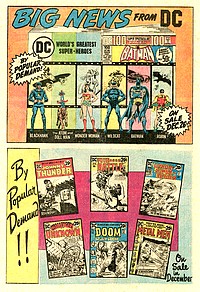
Detective
Comics #432
|
|
| |
|
| |
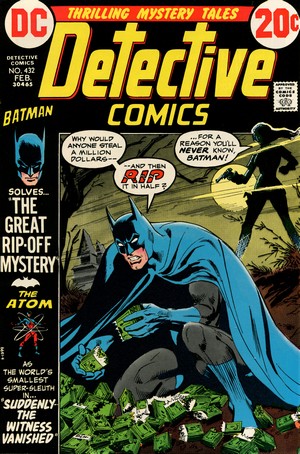
|
|
DETECTIVE
COMICS #432
February 1973
(monthly)
On Sale: 28 December 1972
Editor
- Julius Schwartz
Cover - Dick Giordano (pencils &
inks)
BATMAN: "The Great
Rip-Off Mystery!" (15 pages)
Story -
Frank Robbins
Pencils - Bob Brown
Inks - Murphy Anderson
Lettering - Ben Oda (uncredited)
ATOM: "Suddenly... the
Witness Vanished!" (8 pages)
Story -
Elliot Maggin
Pencils - Murphy Anderson
Inks - Murphy Anderson
PLOT SUMMARIES - Batman
investigates the puzzling murder of a
courier carrying a briefcase full of torn
halves of paper currency. The Atom
deduces that the sudden disappearance of
a witness in court is linked to a ripple
in time and travels back a hundred years
to the past himself.
|
|
|
| |
| It had all started on November 26th 1969, when Detective
Comics #395 hit the news stands with a cover date of
January 1970. It was the first issue of DC's namesake
flagship title written by Dennis O'Neil and drawn by Neal
Adams, and the Batman was about to change in a
fundamental way as he returned to his darker and more
mysterious roots. |
| |
Other writers and artists
were already taking Batman down that path
at the time, but it was O'Neil's concept
that hit home with readers and Batman
editor Julie Schwartz alike.
"We
were going back to what Bill Finger
started with in 1939, and we added to
that what the world had learned about
telling stories since then."
(O'Neil, in Handziuk 2019)
This also resulted in
underscoring the investigative
side of the Batman character -
effectively creating the Darknight
Detective.
"When
I took over the franchise I said
okay, this is the way we do it.
Batman comics will be about superhero
stuff with a lot of action, and
Detective Comics is about the same
character functioning as a
detective." (O'Neil, in
Handziuk 2019)
|
|
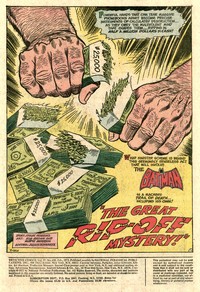 |
|
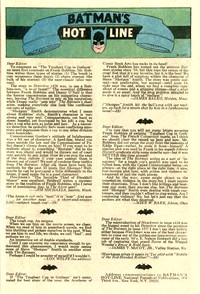 |
|
|
| |
| As a result, Batman and Detective
Comics took two entirely different routes. The most
obvious change for the latter title was the complete
disappearance of costumed villains, all of which were
replaced by plain clothes thugs and evil-doers. |
| |
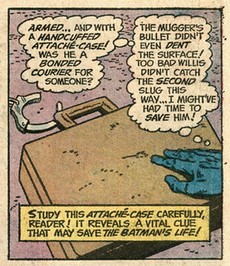
|
|
Detective
Comics #432 is an example of how
Frank Robbins handled this approach,
which often also directly involved
readers in the puzzle solving process -
matching wits and detection skills, so to
speak, with the Batman.
| |
|
|
| This was done by
pointing out that something
depicted in the artwork or
mentioned in the dialogue
contained a vital clue. The
puzzle question put to the
readers was then either answered
directly on the next page or
later on in the story by showing
the Batman put the bits and
pieces together. Robbins, who
was both an artist and a writer,
started working for DC in 1968
and almost immediately took over
the scripting reigns for both Batman
and Detective Comics.
Together with Dennis O'Neil and
Neal Adams, Frank Robbins and
artist Irv Novick are credited
with returning the Batman to his
darker roots and making him a
more brooding character.
|
|
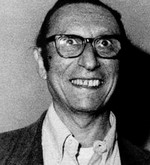
Frank Robbins
(1917-1994)
|
|
|
|
| |
| The clue to be picked up by readers here was the fact
that the attaché-case was obviously bullet-proof - and
since Batman took notice of that, he would later on be
able to use the briefcase as a shield when a mobster
pulled a gun on him. The "can
you solve the puzzle?" approach mostly made for
great reader involvement, and the letters pages at the
time were proof of the fact that it was appreciated and
savoured. It thus also made total sense to have the
tag-line "Thrilling Mystery Tales" on
the covers of Detective Comics.
|
| |
The visuals of most DC characters
were still very much streamlined at the time,
resulting in the (in)famous "DC house
style".
"DC artists
were forced to work within an established
house style that governed the page layout as
well as the look of the artwork."
(Tucker, 2017)
The Batman titles had been
slowly shaking off some of the more stringent
restrictions since 1969. New visual aspects of
the Batman had been defined, and editor Julius Schwartz now made sure
that they were adhered to.
As a
result, the actual artist chosen to draw a
specific issue had a somewhat limited impact on
what readers at the time would perceive.
|
|
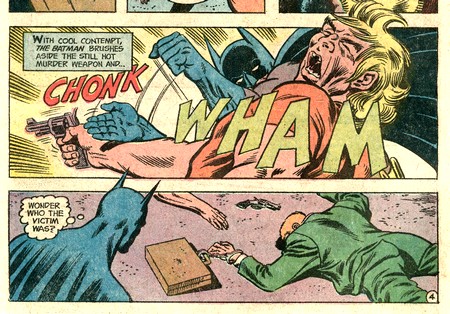 |
|
| |
Bob Brown (1915-1977) started
his career in comic books in the 1940s, and did regular
work for DC and Marvel in the early and mid-1970s,
including almost 40 issues of Batman in Detective
Comics between 1968 and 1973, with issue #432 being
his second to last. Brown, like a number of other
veteran contributors at DC Comics in the early 1970s,
increasingly found his work to be labelled as
"old-fashioned".
"It wasn't so much
that Brown couldn't take a more modern approach to
his work as that he just plain didn't understand what
that meant. Editors kept showing him the work of new
artists, he told me. They'd say, "This is what
we want now," but Brown couldn't grasp just what
it was he was supposed to learn from the examples,
which often struck him as displaying weak anatomy,
poor perspective and other fundamental errors. It
was almost like they were telling him that "Kids
relate to crude artwork" and he knew it wasn't
that." (Evanier, 2004)
It was a tough time for Brown. His
art for Batman in Detective Comics was mostly
solid, and he did attempt to add a few dynamic features
(such as having the artwork break out of the panels).
|
| |
| The back-up feature in Detective
Comics would change frequently during that
period, but a common theme of detective work was
maintained. In this case, the Atom (billed as
"the world's smallest sleuth") solves a
case that is somewhat more "DC
superhero-ish" than other back-up features
(such as Gotham private investigator Jason Bard,
who had occupied that slot in the previous
issue of Detective Comics) - not the
least because the short (8 pages) story involved
time-travel as its major plot linchpin. Both the story by newcomer
Elliot Maggin (who had only started to write for
DC in 1972 and would go on to sign his name as
Elliott S! Maggin, the exclamation mark being a
reference to the abundant use made of it in comic
books) and the artwork by veteran Murphy Anderson
(who had started working for DC in the 1950s)
have a nice flow to them - and the splash page
featuring vignettes that form the name ATOM is
definitely a nice touch.
|
|
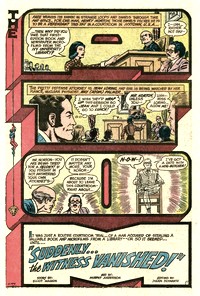 |
|
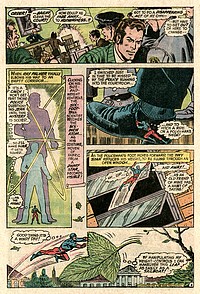 |
|
| |
| The Atom story also features
clues that lead up to the solution and subsequent
explanation of the strange happenings, but they are
simply presented within the story and without directly
putting them to the readers as a brain teaser - which,
given the very specialised local history knowledge needed
to connect the dots, would most likely only have served
to frustrate everybody. But, just like the better classic
crime novels from the 1930s and 1940s, the stories and
mysteries in Detective Comics were always played
fairly - the clues could indeed be spotted, so in essence
the readers always had the same knowledge as the
protagonists did. |
| |
| Jason Bard would return as
back-up feature for the next issue of Detective
Comics, and the Atom would feature next in Action
Comics #425. |
| |
|
 |
|
Detective
Comics was a regular
title in DC's SUPER PACs
- six out of the twelve
issues published in 1973 were
offered in DC's
Super-Pacs. With a bit of
luck, you could therefore
continue reading the
Batman's detective
adventures (albeit in
true DC style without any
plot continuity) from the
previous issue, Detective
Comics #431. |
|
|
|
| |
|
|
| |
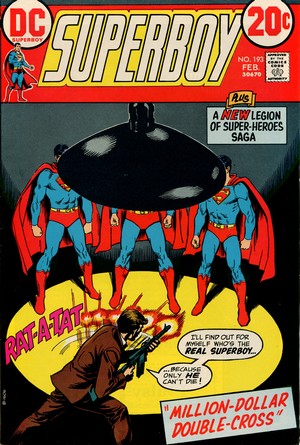
|
|
SUPERBOY #193
February
1973
(monthly,
except January, March,
July and November)
On Sale: 26 December 1972
Editor - Murray
Boltinoff
Cover - Nick Cardy (pencils &
inks)
SUPERBOY:
"The Million-Dollar
Double-Cross!"
(13
pages)
Story
- Cary Bates
Pencils - Bob Brown
Inks - Murphy Anderson
LEGION:
"War between the Nights and
Days!"
(10.5
pages)
Story
- Cary Bates, Nick Pascale
(original idea)
Pencils - Dave Cockrum
Inks - Dave Cockrum
PLOT
SUMMARIES
- Suberboy's friend Pete Ross
lures a criminal gang out of
hiding by pretending to reveal
Superboy's secret identity. The
Legion has to broker peace
between the two factions of
planet Pasnic, one of which lives
in perpetual sunlight, the other
half in perpetual darkness.
|
|
|
|
| |
| Superboy, the youthful
incarnation of Superman, was introduced in 1944 in More
Fun Comics #101 and gained his own book in 1949; Superboy
#193 belongs to this first volume of the title. From
its inception the title Superboy was applied to
Superman's adventures as a boy, teenager or young adult.
The primary setting for the stories was Smallville, but
some plots would stretch the locale to universities
attended by Clark Kent or even as far afield as
time-travel to the 30th
Century for adventures with the Legion of Super-Heroes.. |
| |
| Superboy became only the sixth DC
superhero to receive his own comic book when Superboy
#1 (March–April 1949) was published. Over the
years, the title would see the first appearances
of a number of other DC (supporting) characters,
and according to comichron.com, Superboy
often was the second-best selling superhero title
throughout the Silver Age. The character and its
various adaptations (which would also include
Superbaby) have also been credited with
popularizing the prequel (Barnett, 2020). Before
receiving his own title, Superboy was briefly
moved from More Fun Comics to Adventure
Comics as of issue #103 (April 1946), but
even after starring in Superboy as of
1949 the character continued as the main feature
of Adventure Comics throughout the
1950s, and it was in Adventure Comics #247 (April
1958) that the Legion of Super-Heroes, a group of
superpowered beings living in the 30th and 31st centuries, made its
first appearance, beginning a close connection
with the Superboy character; during the 1960s Adventure
Comics even gained the tag line "featuring
Superboy and the Legion of Super-Heroes".
The Legion moved to the
lead spot as of Adventure Comics #309
(June 1963) with 1950s Superboy reprint stories
as back-ups until making Adventure Comics
a Legion-only title as of issue #346 (July 1966).
This lasted until Adventure Comics #380
(May 1969), when the Legion was relegated to
back-up status and moved to Action Comics
for issues #377-392 (June 1969 - September 1970).
Following a short hiatus, the Legion then
began appearing occasionally as a backup in Superboy,
starting with issue #172 (March 1971).
|
|
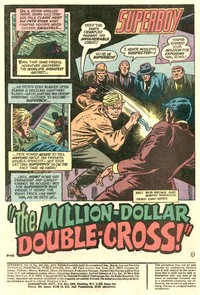 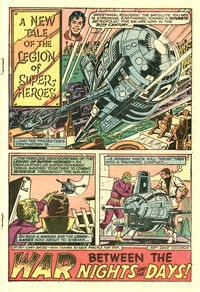
|
|
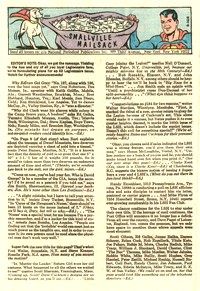 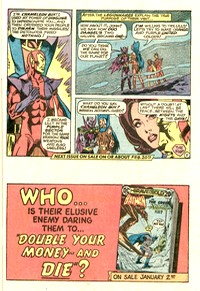
|
|
| |
| Superboy #193 featured a
textbox on the cover reading "Plus: A New Legion
of Super-Heroes Saga"; beginning with issue
#197, this would evolve into the subtitle "Starring
the Legion of Super-Heroes". It also, in some
ways, signalled a (slow) changing of the guard at DC
Comics; whilst the Superboy story is pencilled and inked
by veterans Bob Brown and Murphy Anderson, the Legion
back-up features artwork and inks by newcomer Dave
Cockrum (whose highly acclaimed debut on pencils was the
Legion feature in Superboy #184 in April 1972). |
| |
|
 |
|
Superboy featured
in several of DC's SUPER
PACs (a total of 6 issues in 1973
alone), potentially providing
continued reading of the
adventures of Superboy over
several issues, albeit of course
without any plot continuity (and
potentially changing back-up
features, such as Superbaby in
the previous issue, Superboy
#192,
contained in the D-12 December
1972 SUPER
PAC). |
|
|
|
| |
|
| |
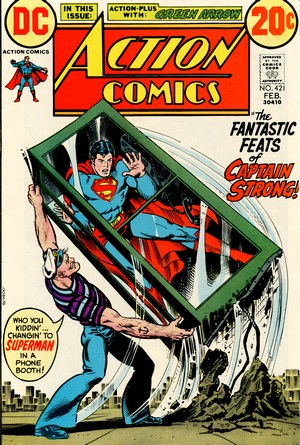
|
|
ACTION
COMICS #421
February
1973
(monthly)
On Sale: 28 December 1972
Editor - Julius
Schwartz, E. Nelson Bridwell
(assistant)
Cover - Nick Cardy (pencils &
inks)
SUPERMAN:
"The
Fantastic Feats of Captain
Strong!" (15.66
pages)
Story
- Cary Bates
Pencils - Curt Swan
Inks - Murphy Anderson
GREEN
ARROW: "The
Headline Maker!" (8
pages)
Story
- Elliot Maggin
Pencils - Sal Amendola
Inks - Dick Giordano
PLOT
SUMMARIES - An
old sailor discovers a plant from
a distant planet that gives him
temporary super powers that rival
those of Superman, whom he
idolizes, but becomes addicted to
it until Superman helps him drop
the habit. In Star City, Green
Arrow not only helps Dinah Lance
open her new flower shop but also
provides her with headline
publicity by taking down a hitman
in front of her store.
|
|
|
|
| |
| When Action Comics #421
hit the newsstands (and the 1973 D-2 Super-Pac), the Man
of Steel's adventures were commonly in the hands of
writers Cary Bates and Elliot Maggin; in this case, Bates
wrote the Superman story and Maggin penned the Green
Arrow back-up. |
| |
Cary Bates belonged to a number
of DC Comics fans who turned writers at a very
young age in the late 1960s and early 1970s,
starting to submit ideas for comic book covers at
the age of 13 (some of which were bought and
published) and selling stories to DC when he was
just 17 years old (Eury, 2013).
"When
I sold my first script in the fall of '66 I
was a freshman in college in Ohio. My parents
started having financial problems around that
time, so had it not been for my writing I
would not have been able to continue paying
tuition… so it would not be inaccurate to
say Superman put me through college. I
graduated with an English degree, which would
have probably led me into teaching had I
stayed in the real world, but I chose to move
to New York to continue writing comics full
time." (Bates in Stroud, 2011)
|
|
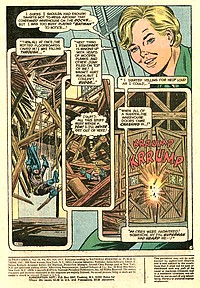 |
|
 |
|
| |
| But
whilst the scripting of Superman and other major DC
characters was entrusted to younger newcomers such as
Bates and Maggin, the artists involved belonged to the
previous generation of DC staffers who had been working
for the company for decades. This in essence teamed up
former fans with the comic book pencillers and inkers
whose work they had enjoyed as young readers, and the age
gap was always there - most visibly so when it came to
attire. |
| |

Cary
Bates
(*1948)

Curt
Swan
(1920-1996)

Murphy
Anderson
(1926-2015)

Sal
Amendola
(*1948)
|
|
Whereas
Bates and Maggin sported long hair and casual
clothes, veterans such as Curt Swan and Murphy
Anderson would always be seen wearing shirts and
dark ties. The relaxed appearance of the younger
staff was only accepted reluctantly by the
veteran DC editors, and there were certain
limits.
"Whenever
I came up to the DC offices to see [Mort
Weisinger], he insisted I wear a tie (...)
Mort once told me he didn't want Jack
Liebowitz (DC's owner back in the day) to
walk by his office to see him talking to
some"hippie". But on the plus side
at least he didn't ask me to get a
haircut." (Bates in Stroud, 2011)
Working with the same creative talent
that had left its mark on DC's 1950s and 1960s
output was also a somewhat mixed blessing.
"I
especially enjoyed my Superman and Flash
stories with Swan and Infantino, since I was
a big fan of both artists when I was reading
DC comics as a kid (...) but in retrospect
though I will say it might have been better
for my career if I had worked with a wider
range of artists, especially some of the
younger up-and-comers of the era."
(Bates in Stroud, 2011)
Long-standing
Superman artists Curt Swan (pencils) and Murphy
Anderson (inks) both produced work that not only
conformed to the DC house style but in many ways
shaped it.
"DC
artists were forced to work within an
established house style that governed the
page layout as well as the look of the
artwork. Editor Julie Schwartz's motto was
'if it's not clean, it's worthless'."
(Tucker, 2017)
By
the time the early 1970s rolled around this was
relaxed a bit, at least when it came to back-up
features. The Green Arrow feature in Action
Comics #421, however, only deviates from the
"clean" DC style in some places.
Sal Amendola was born in
Italy and started working in DC's production
department in 1969, aged 21,where he did
colouring, inking and lettering before taking
over a handful of assignments as a penciller. His art for the
Green Arrow back-up in Action Comics
#421 would, however, remain his only work for
that title.
Amendola's claim to DC
fame is the Batman story "Night of
the Stalker!" which he plotted and
pencilled; based on an idea by Neal Adams, it was
originally rejected by Batman editor Julius
Schwartz and only published several years later
after Archie Goodwin had become the Batman
editor. Finally published in Detective Comics
#439 (February 1974), it has gained the
reputation of being one of the most outstanding
Batman short stories ever.
|
|



|
|
| |
| But there was trouble brewing in
the Superman Universe. Julius Schwartz had only taken
over the editorial reigns of Action Comics two
issues previously, and he wasn't happy at all with its
main character, the Man of Steel. |
| |
"Having spent
much of the previous decade merely observing
from the cultural sidelines, the
now-thirtysomething Superman was hit hard by
the disillusionment that seized the country
in the 1970s (...) Marvel heroes bickered and
questioned and agitated - they were agents of
chaos, and they looked like the kids who read
them. Superman, on the other hand, dutifully
imposed order, and he looked like a
cop." (Weldon, 2013)
And Schwartz wasn't alone
in feeling that the character had somewhat fallen
out of sync with the times.
"O'Neil
shared his editor's ambivalence, because he
figured that such a high-profile character
would come with too many corporate strings
attached. He also found it difficult to get
excited about a character who could see
through time and blow out a star. "How
do you write stories about a guy who can
destroy a galaxy by listening hard?"
O'Neil famously joked." (Weldon,
2013)
Together, Schwartz and
O'Neil reached the conclusion that the only way
forward was to "depower" Superman -
readers needed to see him struggle.
|
|

Julius
Schwartz
(1915 - 2004)
|
|
| |
| And so, they took the man of
Steel's well-known major weakness off the board as all
Kryptonite on Earth was turned into iron by a freak
scientific experiment in Superman #233 (January
1971). At the same time, Superman's powers started to
mysteriously fade. It was a nice idea, but there simply
were too many "super-this" and
"super-that" abilities tied into Superman as a
character, and Clark Kent was still constantly having to
foil the discovery of his dual identity. |
| |
 |
|
At the end of
the day, not too much changed after all - except
O'Neil didn't want to write Superman anymore
(Freiman, 2009). Possibly the most problematic
aspect, however, were the villains: mostly far
fetched, convoluted, and bland. Captain Strong is
somewhat different, but ultimately the character
and the story come across as "cute"
more than anything else, and extremely sanitized.
The very much tongue-in-cheek cover depicting
Superman trapped in the iconic telephone box /
phone booth, however, is topnotch - Nick Cardy
clearly having fun taking the mickey out of a
classic Superman cliché.
|
|
| |
| But overall, unless you were a
die-hard Superman fan, a lot of those stories didn't
really seem to go anywhere relevant. In comparison to
Marvel's output, the Superman fare also seemed to be very
much on the meek and mild side. Not surprisingly, many
readers bought Action Comics not because they
were fans of Superman, but because of the second features
appearing in the title (Kingman, 2013), but in the case
of the Green Arrow story in Action Comics #421,
this too lacks any kind of edge to it. |
| |
|
| |
 |
|
Fans of Action
Comics would not be able to
find the next issue in any DC
SUPER-PAC and would have to wait
for Action Comics #423,
packaged into the D-4 (April)
1973 three-pack. |
|
|
|
| |
|
| |
| FURTHER
READING ON THE THOUGHT
BALLOON |
| |
| |
 |
|
"Comic
packs" not only sold well
for more than two decades, they
also offer some interesting
insight into the comic book
industry's history from the 1960s
through to the 1990s. There's
more on their general history here. |
| |
|
|
|
|
|
 |
|
An overview
and analysis of all the 1973
Super Pacs is available
here. |
|
|
|
| |
| |
|
| |
BIBLIOGRAPHY
| |
| |
| BARNETT David (2020) "From
‘Endeavour’ to the resurrection of Nurse
Ratched: Why we love a prequel", The
Independent, 27 September 2020 EURY Michael
(2013) "A Super Salute to Cary Bates", Back
Issue! #62, TwoMorrows
EVANIER
Mark (2004) "On
the Passing of Bob Haney", News From
Me, published online 7 December 2004
EVANIER
Mark (2007) "More
on Comicpacs", News From Me,
published online 2 May 2007
FREIMAN Barry
M. (2009) "Exclusive
Interview with Elliot S! Maggin", supermanhomepage.com,
published online January 2009
HANDZIUK Alex
(2019) "An
Interview with Legendary Creator Denny O'Neil -
The father of Modern Day Batman", cgmagonline.com,
published online 16 March 2019
KINGMAN
Jim (2013) "The Ballad of Ollie and
Dinah", in Back Issue #64 (May
2013)
STROUD
Bryan (2011) "Cary
Bates Interview", wtv-zone.com,
published online 14 October 2011
TUCKER
Reed (2017) Slugfest: Inside the Epic
Fifty-Year Battle between Marvel and DC,
Sphere
WELDON
Glen (2013) "The
70s Were Awkward for Superman", The
Atantic, 3 April 2013
|
|
| |
| |
|
| |


|
| |
|
| |

(c) 2024-2025
uploaded to the web 18
February 2024
minor corrections 17 August 2025
|
| |
|
| |
|





































